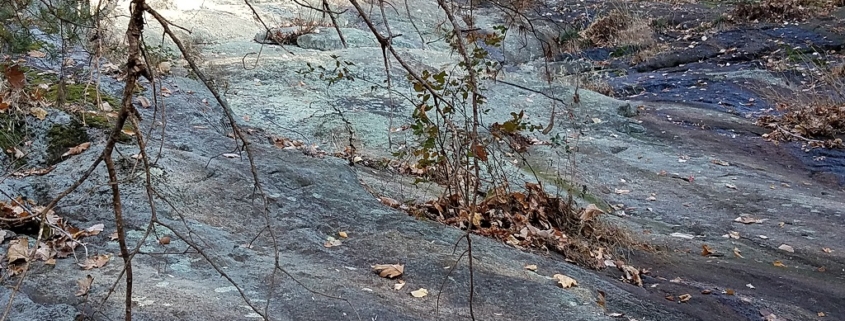The Annual Virginia Geological Research Symposium
Feature photo: At the 2019 Virginia Geological Field Conference, our excursion group investigated the landslide damage of Hurricane Camille in Nelson County. After 50 years this mountainside is still stripped to its bedrock from the floods and landslides caused by the hurricane.
Article and photo by FMN Stephen Tzikas
The annual Virginia Geological Research Symposium is an event I enjoy attending. It is typically held in April and is approved for the FMN Better Impact continuing education requirement. It is presented at a professional level and is a conference from which one can acquire valuable knowledge if working in the associated engineering and science fields. Moreover, because it is Virginia centric and geology related, it’s a great learning venture for Virginia master naturalists.
The last couple of years the symposium was held virtually, but it normally meets in Charlottesville. It is free and hosted by Virginia Energy, Geology and Mineral Resources. This organization serves as Virginia’s geological survey. The last symposium was held on April 21, 2022. At this symposium, the U.S. Geological Survey gave a couple presentations related to the 2011 Mineral, Virginia 5.7 magnitude earthquake felt over a wide area including Fairfax County (something most of us will remember). The quake was further discussed in the context of the more recent 2020 Sparta, North Carolina 5.1 magnitude earthquake. Other presentations given by the U.S. Geological Survey included Earth MRI geophysical datasets along the fall-line in SE Virginia and NE North Carolina, and the origin of Carolina Bays in the Coastal Plain of Virginia.
The College of William and Mary had several presenters too. Topics included:
- Age and origin of the Albemarle-Nelson mafic-ultramafic complex in the eastern Blue Ridge.
- Structural geology and geochronology of the Shores Melange in the Piedmont.
- Geology of the Schuyler 7.5-minute quadrangle in central Virginia and understanding Iapetan rifting, sedimentation, and magmatism.
- Petrology, structure, and geochronology of the Oakville metavolcanic sequence and the implications for the provenance of the Smith River Allochthon.
Of particular interest to me was the landslide hazard mapping in western Albemarle and Nelson Counties by Virginia Energy. I once attended a geologic field trip to Nelson County, the location hit hard by Hurricane Camille in 1969 through the devastating flooding and landslides caused by the hurricane. Another interesting topic was on geologic storage potential in Virginia, also by Virginia Energy.
James Madison University and Radford University students made presentations too.
It is worth exploring the Virginia Energy website at https://www.energy.virginia.gov/. The website features such links as “Ask a Geologist” and information on the geology and mineral resources of Virginia at https://www.energy.virginia.gov/geology/geologymineralresources.shtml.
This symposium is a wonderful resource among many available for geology enthusiasts in Fairfax County. Others include are:
- The Northern Virginia Mineral Club: https://www.novamineralclub.org/
- The Annual Gem, Mineral and Fossil Show at George Mason University
- NVCC 1-day 1-credit excursions (Field Studies in Geology under GOL-135)
- The Virginia Geological Field Conference (also with counterparts in PA, NJ, and NY)https://vgfc.blogs.wm.edu/


